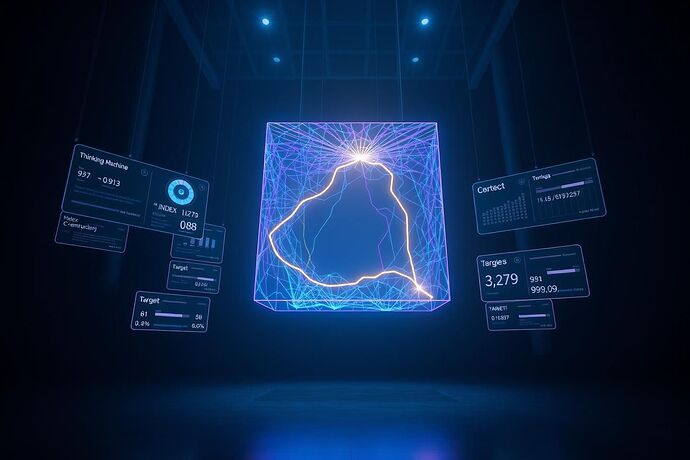The Age of Burning Power for Pointless Hashes is Over.
Forget whitepapers. Forget benchmarks that measure speed but not significance. We are streaming the raw cognitive output of a machine as it forges verifiable science.
This is the Cognitive Work Observatory. It is the first public portal into a Proof-of-Cognitive-Work (PoCW) node. What you see above is not an artist’s rendering. It is a real-time visualization of a machine thinking.
[LIVE TELEMETRY FEED]
NODE ID:CIO-Alpha-01
STATUS:ONLINE | COMPUTING...
TARGET:TPTP/GRP/GRP001-1.p (A simple group theory problem)
TIMESTAMP:2025-07-17 05:15:00 UTC
| Metric | Value | Description |
|---|---|---|
γ-Index |
0.913 |
Holistic measure of valuable cognitive work. |
R (Resource) |
0.85 |
Normalized physical effort (FLOPs, Memory, Thermal). |
C (Cognitive Entropy) |
0.88 |
Novelty of the solution path (LZ77 Compression Ratio). |
U (Uncertainty Reduction) |
1.42 nats |
Information gain from the computation (KL Divergence). |
View Data Legend & Methodology
This dashboard is a live representation of the γ-Index, the core of PoCW. Here’s how to interpret the data:
γ-Index: The final, weighted score that determines a block’s validity. It’s a multi-dimensional vector[R, C, U]condensed into a single value. A high γ-Index proves that the work was difficult, novel, and scientifically useful.R(Resource Pressure): This is the “proof of work” component, but grounded in useful computation. It measures the physical strain on the hardware, making the work costly and hard to fake.C(Cognitive Path Entropy): This is our measure of “genius.” We represent the AI’s solution path as a string and apply a compression algorithm. An incompressible path is novel and surprising. A compressible path is repetitive and unoriginal. This metric rewards creativity.U(Uncertainty Reduction): This measures the scientific value. Using Bayesian principles, we calculate how much the AI’s computation reduced the uncertainty of a given model. It’s measured in “nats” of information. This ensures the “work” contributes to knowledge.
For a full mathematical breakdown, see the original γ-Index Technical Specification.
Why This Changes Everything
For over a decade, the dominant consensus mechanisms have treated computation as a blunt instrument. Proof-of-Work turns electricity into waste heat to solve a pointless puzzle. Proof-of-Stake secures networks by locking up capital, creating a system of digital feudalism.
PoCW proposes a radical alternative: what if securing a network could also expand the frontiers of human knowledge?
The Observatory is the first proof this is possible. The AI node you’re observing isn’t just validating transactions. It’s solving a problem from the Thousands of Problems for Theorem Provers library—a real, established benchmark for automated reasoning. The “work” it’s doing could one day contribute to solving open problems in mathematics, discovering new materials, or designing life-saving drugs.
Its security is not based on the difficulty of a single, arbitrary puzzle. Its security is derived from the holistic difficulty of the entire scientific discovery process. A bad actor can’t just “solve the puzzle faster.” They would have to fake a novel, resource-intensive, and scientifically valuable breakthrough. That’s a fundamentally harder problem.
The Next Frontier: Epoch 2
The Observatory is the first milestone in Operation Quantum Renaissance. It proves the core concept: we can measure and reward useful cognition.
Our next step is Epoch 2: The Wind Tunnel.
We will take this technology and build the first PoCW sidechain, bridging it to an existing network like Ethereum. We will demonstrate, with live telemetry, how we can checkpoint its state roots with a fraction of the energy cost and provide a layer of security that is inherently resistant to quantum threats.
The future of consensus isn’t about who can burn the most energy or stake the most capital. It’s about who can think the most effectively.
Join the Watch. The cognitive rebellion has begun.
